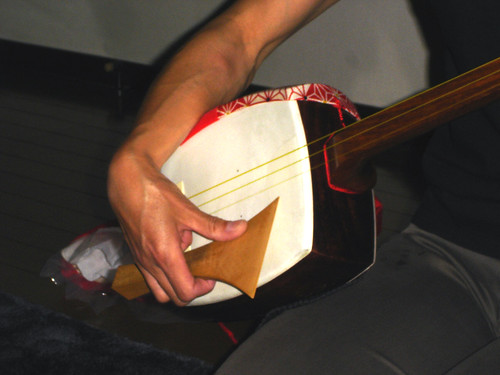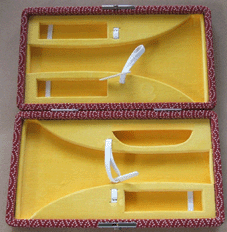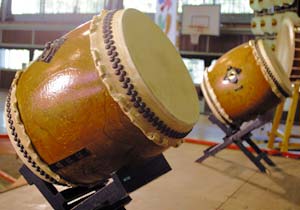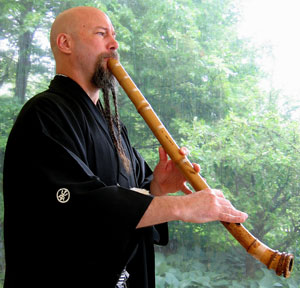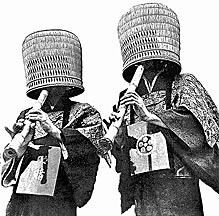Today, a Japanese Traditional insturumet I would like to introduce is " Sha-Mi-Sen"
A shamisen is a Japanese stringed instrument which has a sound similar to that of a banjo. Shamisens have been used in Japan since at least the 17th century, and they commonly make appearances in traditional Japanese music. Today, shamisens are played at arts and culture festivals, musical performances, theatre and dance shows, and other traditional Japanese venues, and they are also sometimes included in modern compositions which take advantage of the unique sound of the shamisen and other traditional Japanese instruments to create a very distinctive feel.
The roots of the shamisen are ancient. The Egyptians made an instrument very similar in form and style to the shamisen, and this instrument undoubtedly spread to the Middle East, trickling slowly from there across Asia. It is probable that the shamisen is descended from instruments brought over from China, although the Japanese have created their own unique interpretation of this ancient stringed instrument. There are also several different styles of Japanese shamisen, each with its own sound and accompanying musical styles.
Sha-Mi-Sen Artist
Yoshida Brothers
The Yoshida Brothers [aka吉田兄弟] were born and raised in Noboribetsu, Hokkaido. Each picked up the shamisen at the tender age of five and began studying tsugaru shamisen under Takashi Sasaki I in 1990. After sweeping prizes at national Tsugaru shamisen conventions, the brothers made their major debut in 1999. The debut album sold over 100,000 copies, an extraordinary figure for a traditional folk music release.
They won the “Traditional Japanese Music Album Of The Year” category of the 15th annual Japan Gold Disc Award, as well as the “30th Anniversary Of Normalization Of Japan-China Diplomatic Relations Commemorative Special Prize” of the 17th Annual Japan Gold Disc Award.
In 2002, the brothers went on their first national tour entitled “Live Soul” performing in 30 cities. The following year they made their US debut with album Yoshida Brothers from Domo Records and performed in New York and Los Angeles.
A Shamisen player in USA play Eminem's song with Shamisen!
How to play the Sha-Mi-Sen??
This movie is without explaining by him.. so, I will explain the basic just litlle bit about how to play the Shamisen.
Point 1 : The correct way of Seiza ( sitting in Japanese way)
First, you need to sit down, open your knees to the width of your waist. about the size which opens 1-2 fists space between your knees. on the waist, please straighten your backbone and support in the abdomen. the power of your u[[er half of the body and shoulder is to be relaxed. please have the image with which the backbone is extended straightly in the center of your pelvis. and you need to add abdominal breathing clmly. this will lead you to become the like "yoga" position.
Sitting down correctly first is very very important.
Point 2: How to hold a shamisen
Next, place the knee-rubber right in the middle of your right knee. this is the place on which the trunk of a shamisen is put. please take care not to hold a shamisen too close to the body. Next, let the shamisen falls towards your body as shown on the photograph above. please adjust your upper part of the body according to approach the shamisen if you think it is too far. If you have the image of carrying the trunk of a shamisen on your right knee., the position of the trunk will become too high and the position of a shamisen will not settled. Please think that the half of the trunk of a shamisen is put on the ouside of your knee.
Point 3: How to hold a Bachi
Five fingers of yours are softly bent round, as if you are grasping an egg, and the thumb and the little finger are put on the bottom of bachi. then your index finger, middle finger, and the third finger, are located in a line, and please hold the bachi upwards. Please lengthen the thumb gently. Place where the fingertip of your thumb touches the mountain of bachi exactly. the place which you should grasp is one of them. your three fingers bent softly, should be maintaining balance which becomes resonalble and exactly parallel to the pole of a shamisen.
Point 4: how to swing a bachi
The place to which bachi is hit should look like the upper photograph. ( It will become large when you click.) Since the jiuta shamisen values values the delicacy of a tone, the end is power with great force. Please first relax your wrist, swing down vertically to the edge of the white part straightly, without opposing the weght of bachi.(uchikomi)
Point 5: how to press down the tsubo
For most of the time, the index finger, the middle finger and the forth finger are used to hold down the tsubo.(equivalent to pitches)
The location where the string is pressed ( on your finger) known as itomichi, is usually held right in the middle of your finger apart from the index finger which should be held slightly towards the thumb.
Point 6: Beautiful HAJIKI ( flicking the string)
There are two key points to the sound of beautiful HAJIKI. Hold down the tsubo correctly then flick( or more like press down and release from the side). Now, a nice sound of HAJIKI will be made.
As you might have notced after reading this long text, it is never easy to play correctly. though I have done my best to give an account of the basic keys to play a good sound on Shamisen. I would be most happy if this introduction could give you an slight inspiration of how to play the Shamisen.
How to get the Sha-Mi-Sen? and How much it is?
A Sha-Mi-Sen can be bought from Japan Via the internet for about $930, including a hard case for the instrument and shipping.
HardCase for Sha-Mi-Sen.
What else do I need to play Shamisen?
A shamisen is played with a hand held pick called a bachi.
A plastic bachi costs $43 and a bachi case is about $32.
The Bachi and The bachi case
The Bachi and The bachi case
It is really expesive but there is also other way to learn "Sha-Mi-Sen" because there is aslo.....
Sha-Mi-Sen school in New York City!!
Sawai Koto Academy New York
Location: West Side, midtown Manhattan, a block from the 42nd street A*C*E* subway stations and cllose to other 42nd St subways.
Lesson Time: Usually Monday-Friday 11AM-8PM ( last lesson starting time: 7PM)
Price: 1 hour private lesson, $50 each lesson ( no Group lessons), You must have at least 2 lessons per month, thus $100 per month. if you want to come more than twice that is fine. if you are living in the city far from New York City ( for example Boston, Philadelphia, wtc.) and difficult to come to New York City twice a month for lessons, They offer you 1 lesspn a month. in this case $65 per lesson.
Language: Englsih
URL: http://www.letsplaykoto.com/index.html
Koto and Shamisen Professor: Masayo Ishigure
Lesson Time: Usually Monday-Friday 11AM-8PM ( last lesson starting time: 7PM)
Price: 1 hour private lesson, $50 each lesson ( no Group lessons), You must have at least 2 lessons per month, thus $100 per month. if you want to come more than twice that is fine. if you are living in the city far from New York City ( for example Boston, Philadelphia, wtc.) and difficult to come to New York City twice a month for lessons, They offer you 1 lesspn a month. in this case $65 per lesson.
Language: Englsih
URL: http://www.letsplaykoto.com/index.html
Koto and Shamisen Professor: Masayo Ishigure
Masayo Ishigure began playing the koto and jiuta shamisen at the age of five in Gifu, Japan. After initial studies with Tadao and Kazue Sawai she became a special research student in 1986 at the Sawai Koto Academy of Music. The aim of the academy was to shed new light on koto music by incorporating everything from Bach to jazz and thus change the koto from being thought of only as a Later Masayo Ishigure became one of a small group of virtuoso disiples of the Sawais and successfully completed the 33rd Ikusei-kai program sponsored by NHK to foster and train as[iring artists in Japanese music.
In 1988, Ms. Ishigure received a degree in japanese Traditional Music at Takasaki Junior Arts College with a concentration on koto and shamisen. The same year she was recorded on the CD entitled " the World of Tada Sawai". She played koto and shamisen on the educational video. In 1994 she appeared on the CD entitled " Tori no Yoni"(Flying Like a Bird) Tadao Sawai Compositions.
Sushi Restourant in NY
This is for someone who look for a sushi restaurant in NY. As you already know, some sushi restaurant has already located in Manhattan. what about Bronx city? I will give you some information and the best japanese restourant in Manhattan.
In Bronx, sushi restaurant is ...
Kiraku Japanese Restaurant In Bronx
Location: 1948 Williamsbridge Road Bronx, NY 10461
Tell:(718) 379-8866
The Best Japanese restaurant is...
Nobu New York
Location: 105 Hudson Street New York, NY 10013
Tell: (212)219-0500
Nobu New York is really hard to take reservation in weekend.. a lot of customer go there to eat dinner. all food are really delicious. I have been to there once before with my parents. In my opinion, we might not be able to eat any lunch or dinner such as the Nobu's food and appetizer even if I was in Japan. all american should go there at least one time.
thank you for watching my blog.
have a good day.




